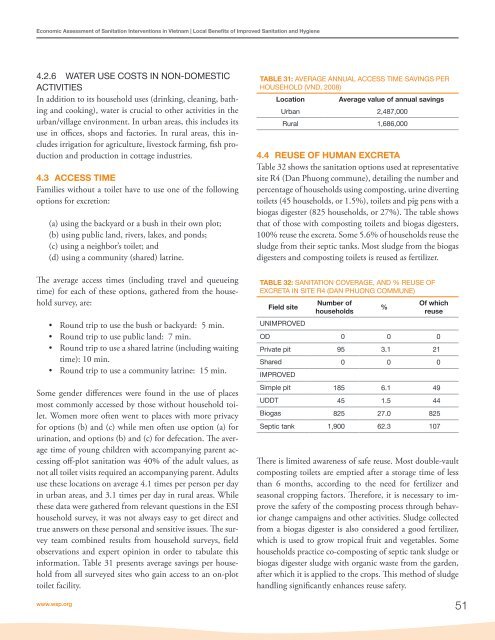Economic Assessment of Sanitation Interventions in Vietnam - WSP
Economic Assessment of Sanitation Interventions in Vietnam - WSP
Economic Assessment of Sanitation Interventions in Vietnam - WSP
You also want an ePaper? Increase the reach of your titles
YUMPU automatically turns print PDFs into web optimized ePapers that Google loves.
<strong>Economic</strong> <strong>Assessment</strong> <strong>of</strong> <strong>Sanitation</strong> <strong>Interventions</strong> <strong>in</strong> <strong>Vietnam</strong> | Local Benefits <strong>of</strong> Improved <strong>Sanitation</strong> and Hygiene4.2.6 WATER USE COSTS IN NON-DOMESTICACTIVITIESIn addition to its household uses (dr<strong>in</strong>k<strong>in</strong>g, clean<strong>in</strong>g, bath<strong>in</strong>gand cook<strong>in</strong>g), water is crucial to other activities <strong>in</strong> theurban/village environment. In urban areas, this <strong>in</strong>cludes itsuse <strong>in</strong> <strong>of</strong>fices, shops and factories. In rural areas, this <strong>in</strong>cludesirrigation for agriculture, livestock farm<strong>in</strong>g, fish productionand production <strong>in</strong> cottage <strong>in</strong>dustries.4.3 ACCESS TIMEFamilies without a toilet have to use one <strong>of</strong> the follow<strong>in</strong>goptions for excretion:(a) us<strong>in</strong>g the backyard or a bush <strong>in</strong> their own plot;(b) us<strong>in</strong>g public land, rivers, lakes, and ponds;(c) us<strong>in</strong>g a neighbor’s toilet; and(d) us<strong>in</strong>g a community (shared) latr<strong>in</strong>e.The average access times (<strong>in</strong>clud<strong>in</strong>g travel and queue<strong>in</strong>gtime) for each <strong>of</strong> these options, gathered from the householdsurvey, are:• Round trip to use the bush or backyard: 5 m<strong>in</strong>.• Round trip to use public land: 7 m<strong>in</strong>.• Round trip to use a shared latr<strong>in</strong>e (<strong>in</strong>clud<strong>in</strong>g wait<strong>in</strong>gtime): 10 m<strong>in</strong>.• Round trip to use a community latr<strong>in</strong>e: 15 m<strong>in</strong>.Some gender differences were found <strong>in</strong> the use <strong>of</strong> placesmost commonly accessed by those without household toilet.Women more <strong>of</strong>ten went to places with more privacyfor options (b) and (c) while men <strong>of</strong>ten use option (a) forur<strong>in</strong>ation, and options (b) and (c) for defecation. The averagetime <strong>of</strong> young children with accompany<strong>in</strong>g parent access<strong>in</strong>g<strong>of</strong>f-plot sanitation was 40% <strong>of</strong> the adult values, asnot all toilet visits required an accompany<strong>in</strong>g parent. Adultsuse these locations on average 4.1 times per person per day<strong>in</strong> urban areas, and 3.1 times per day <strong>in</strong> rural areas. Whilethese data were gathered from relevant questions <strong>in</strong> the ESIhousehold survey, it was not always easy to get direct andtrue answers on these personal and sensitive issues. The surveyteam comb<strong>in</strong>ed results from household surveys, fieldobservations and expert op<strong>in</strong>ion <strong>in</strong> order to tabulate this<strong>in</strong>formation. Table 31 presents average sav<strong>in</strong>gs per householdfrom all surveyed sites who ga<strong>in</strong> access to an on-plottoilet facility.TABLE 31: AVERAGE ANNUAL ACCESS TIME SAVINGS PERHOUSEHOLD (VND, 2008)LocationAverage value <strong>of</strong> annual sav<strong>in</strong>gsUrban 2,487,000Rural 1,686,0004.4 REUSE OF HUMAN EXCRETATable 32 shows the sanitation options used at representativesite R4 (Dan Phuong commune), detail<strong>in</strong>g the number andpercentage <strong>of</strong> households us<strong>in</strong>g compost<strong>in</strong>g, ur<strong>in</strong>e divert<strong>in</strong>gtoilets (45 households, or 1.5%), toilets and pig pens with abiogas digester (825 households, or 27%). The table showsthat <strong>of</strong> those with compost<strong>in</strong>g toilets and biogas digesters,100% reuse the excreta. Some 5.6% <strong>of</strong> households reuse thesludge from their septic tanks. Most sludge from the biogasdigesters and compost<strong>in</strong>g toilets is reused as fertilizer.TABLE 32: SANITATION COVERAGE, AND % REUSE OFEXCRETA IN SITE R4 (DAN PHUONG COMMUNE)Field siteUNIMPROVEDNumber <strong>of</strong>households%Of whichreuseOD 0 0 0Private pit 95 3.1 21Shared 0 0 0IMPROVEDSimple pit 185 6.1 49UDDT 45 1.5 44Biogas 825 27.0 825Septic tank 1,900 62.3 107There is limited awareness <strong>of</strong> safe reuse. Most double-vaultcompost<strong>in</strong>g toilets are emptied after a storage time <strong>of</strong> lessthan 6 months, accord<strong>in</strong>g to the need for fertilizer andseasonal cropp<strong>in</strong>g factors. Therefore, it is necessary to improvethe safety <strong>of</strong> the compost<strong>in</strong>g process through behaviorchange campaigns and other activities. Sludge collectedfrom a biogas digester is also considered a good fertilizer,which is used to grow tropical fruit and vegetables. Somehouseholds practice co-compost<strong>in</strong>g <strong>of</strong> septic tank sludge orbiogas digester sludge with organic waste from the garden,after which it is applied to the crops. This method <strong>of</strong> sludgehandl<strong>in</strong>g significantly enhances reuse safety.www.wsp.org51
















